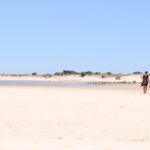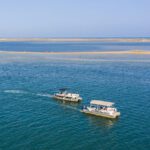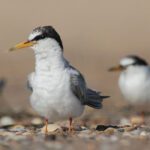Sternula albifrons (Pallas, 1764) is the smallest tern found in Europe, and that why it’s called Little Tern.
The Little Tern is almost half the size of the Common Tern and its length ranges from 21 up to 25 cm and a wingspan of 41 up to 47 cm. The juveniles have black bills with yellow base, and during breeding plumage the adults have a black crown and white forehead, yellow bill with a black tip, yellow legs and its upper parts are black, white and grey.
This small coastal bird is classified as a vulnerable species, in Portugal. It’s a migrator that visits the Ria Formosa Nature Park in Spring and Summer and spends the Winter in Africa (between Guinea and Camarões). Between 2000 and 2002, Ria Formosa has an estimated population of 440 breeding couples. Although the breeding population is stable since the 70’s, there is a record of a reduction of their breeding areas, especially concerning the habitat reduction of the barrier islands which are decreasing at a rate of 1,7m/year. For this reason, the breeding areas of the Little Tern have been moving from the beach sandy areas towards the salt pans.
It arrives to the Ria Formosa Nature Park mid April and starts to breed mid May. This species nests in colonies of about 2 to 50 couples. It’s a beach nesting bird, preferring isolated barrier islands, between the vegetation and above the high water line and less frequently in salt pans. Its´ nests are a bare scrape in the ground, decorated with fragments of vegetation, small stones and shells. During courtship an interesting habit to see is the male offering small fish to the female.
The Little Tern lays its first eggs (1 to 3 at a time) mid May. The eggs hatch after 20 days and both male and female are responsible for parental care. The newborns, 4/5 days old, start to leave the nest to more protected areas. After 20 days, the chicks are ready to fly and they start their first migration route along with their parents. They will be fed by both parents for the next 2 to 3 months.
The Little Tern feeding habits are mainly of small fish and eventually they also feed of insects, molluscs and annelids. To catch their prey, they fly over the water, scanning for fish, and as soon as they spot one they stop and start hovering, flapping their wings very fast, doing an incredible fast dive to catch their prey.
The Little Tern is one of the most frequently sighted species in Ria Formosa during spring and summer, so if you want to see this lovely bird closely we invite to join us on ourboat tours departing from Faro or from Tavira.







